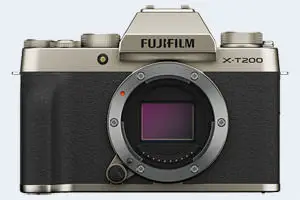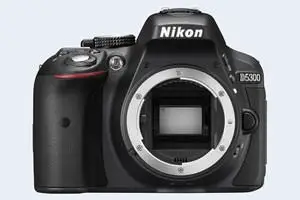Fujifilm X-T200 vs Nikon D5300
The Fujifilm X-T200 and the Nikon D5300 are two digital cameras that were officially introduced, respectively, in January 2020 and October 2013. The X-T200 is a mirrorless interchangeable lens camera, while the D5300 is a DSLR. Both cameras are equipped with an APS-C sensor. Both cameras offer a resolution of 24 megapixels.
Below is an overview of the main specs of the two cameras as a starting point for the comparison.

Check X-T200 offers at
ebay.com

Check D5300 offers at
ebay.com
Going beyond this snapshot of core features and characteristics, what are the differences between the Fujifilm X-T200 and the Nikon D5300? Which one should you buy? Read on to find out how these two cameras compare with respect to their body size, their imaging sensors, their shooting features, their input-output connections, and their reception by expert reviewers.
Body comparison
The side-by-side display below illustrates the physical size and weight of the Fujifilm X-T200 and the Nikon D5300. The two cameras are presented according to their relative size. Three successive views from the front, the top, and the rear are shown. All size dimensions are rounded to the nearest millimeter.
The X-T200 can be obtained in three different colors (silver, gold, titanium), while the D5300 is also available in three color-versions, but different ones (black, grey, red).
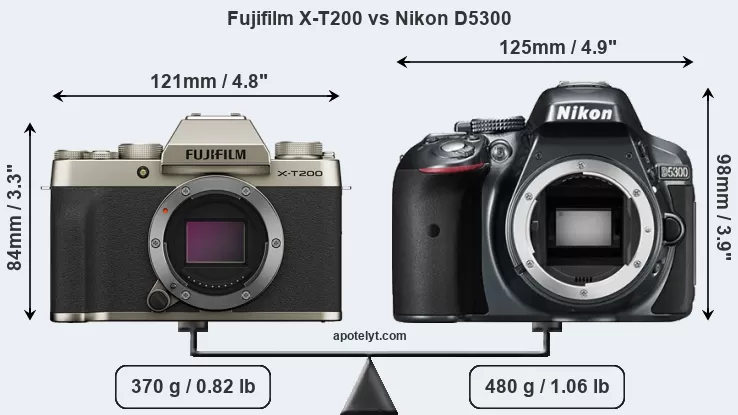

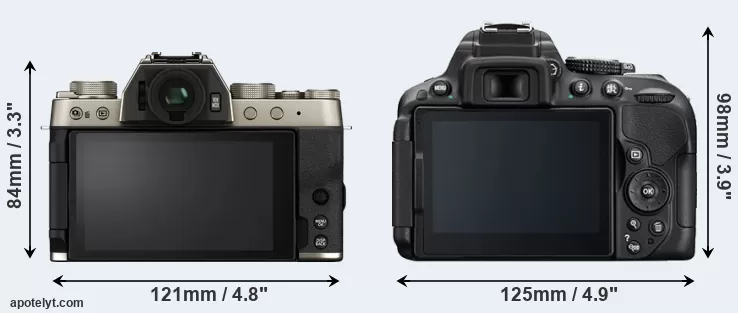
If the front view area (width x height) of the cameras is taken as an aggregate measure of their size, the Nikon D5300 is notably larger (21 percent) than the Fujifilm X-T200. Moreover, the D5300 is markedly heavier (30 percent) than the X-T200. In this context, it is worth noting that neither the X-T200 nor the D5300 are weather-sealed.
The above size and weight comparisons are to some extent incomplete since they do not consider the interchangeable lenses that both of these cameras require. Both cameras have similarly sized sensors, but DSLRs have a larger flange-to-focal plane distance than mirrorless cameras, which imposes contraints on the optical engineering process and generally leads to bigger and heavier lenses. You can compare the optics available for the two cameras in the Fujinon X Lens Catalog (X-T200) and the Nikon Lens Catalog (D5300). Mirrorless cameras, such as the Fujifilm X-T200, have moreover the advantage that they have a relatively short flange to focal plane distance and can thus use many lenses from other systems via adapters.
Concerning battery life, the X-T200 gets 270 shots out of its Fujifilm NP-W126S battery, while the D5300 can take 600 images on a single charge of its Nikon EN-EL14a power pack. The power pack in the X-T200 can be charged via the USB port, so that it is not always necessary to take the battery charger along when travelling.
The adjacent table lists the principal physical characteristics of the two cameras alongside a wider set of alternatives. If you want to switch the focus of the display and review another camera pair, you can move across to the CAM-parator tool and choose from the broad selection of possible camera comparisons there.

| # | Camera Model |
Camera Width |
Camera Height |
Camera Depth |
Camera Weight |
Battery Life |
Weather Sealing |
Camera Launch |
Launch Price (USD) |
Street Price |
|
|---|---|---|---|---|---|---|---|---|---|---|---|
| 1. | Fujifilm X-T200 | 121 mm | 84 mm | 55 mm | 370 g | 270 | n | Jan 2020 | 699 | ebay.com | |
| 2. | Nikon D5300 | 125 mm | 98 mm | 76 mm | 480 g | 600 | n | Oct 2013 | 799 | ebay.com | |
| 3. | Fujifilm X-E4 | 121 mm | 73 mm | 33 mm | 364 g | 380 | n | Jan 2021 | 849 | amazon.com | |
| 4. | Fujifilm X-T30 II | 118 mm | 83 mm | 47 mm | 383 g | 380 | n | Sep 2021 | 899 | amazon.com | |
| 5. | Fujifilm X-T30 | 118 mm | 83 mm | 47 mm | 383 g | 380 | n | Feb 2019 | 899 | ebay.com | |
| 6. | Fujifilm X-A7 | 119 mm | 68 mm | 41 mm | 320 g | 440 | n | Sep 2019 | 499 | ebay.com | |
| 7. | Fujifilm X-T100 | 121 mm | 83 mm | 47 mm | 448 g | 430 | n | May 2018 | 599 | ebay.com | |
| 8. | Fujifilm X-E3 | 121 mm | 74 mm | 43 mm | 337 g | 350 | n | Sep 2017 | 899 | ebay.com | |
| 9. | Fujifilm X-T20 | 118 mm | 83 mm | 41 mm | 383 g | 350 | n | Jan 2017 | 899 | ebay.com | |
| 10. | Fujifilm X-A3 | 117 mm | 67 mm | 40 mm | 339 g | 410 | n | Aug 2016 | 399 | ebay.com | |
| 11. | Fujifilm X-E2S | 129 mm | 75 mm | 37 mm | 350 g | 350 | n | Jan 2016 | 699 | ebay.com | |
| 12. | Fujifilm X-T10 | 118 mm | 83 mm | 41 mm | 381 g | 350 | n | May 2015 | 799 | ebay.com | |
| 13. | Nikon D5600 | 124 mm | 97 mm | 70 mm | 465 g | 970 | n | Nov 2016 | 699 | ebay.com | |
| 14. | Nikon D5500 | 124 mm | 97 mm | 70 mm | 470 g | 820 | n | Jan 2015 | 899 | ebay.com | |
| 15. | Nikon D3300 | 124 mm | 98 mm | 76 mm | 430 g | 700 | n | Jan 2014 | 499 | ebay.com | |
| 16. | Nikon D3200 | 125 mm | 96 mm | 77 mm | 505 g | 540 | n | Apr 2012 | 599 | ebay.com | |
| 17. | Nikon D5200 | 129 mm | 98 mm | 78 mm | 555 g | 500 | n | Nov 2012 | 749 | ebay.com | |
| Note: Measurements and pricing do not include easily detachable parts, such as add-on or interchangeable lenses or optional viewfinders. | |||||||||||
Any camera decision will obviously take relative prices into account. The retail prices at the time of the camera’s release place the model in the market relative to other models in the producer’s line-up and the competition. The X-T200 was launched at a somewhat lower price (by 13 percent) than the D5300, which makes it more attractive for photographers on a tight budget. Usually, retail prices stay at first close to the launch price, but after several months, discounts become available. Later in the product cycle and, in particular, when the replacement model is about to appear, further discounting and stock clearance sales often push the camera price considerably down.
Sensor comparison
The size of the sensor inside a digital camera is one of the key determinants of image quality. A large sensor will tend to have larger individual pixels that provide better low-light sensitivity, wider dynamic range, and richer color-depth than smaller pixel-units in a sensor of the same technological generation. Moreover, a large sensor camera will give the photographer more control over depth-of-field in the image and, thus, the ability to better isolate a subject from the background. On the downside, larger sensors are more costly to manufacture and tend to lead to bigger and heavier cameras and lenses.
Both cameras under consideration feature an APS-C sensor, but their sensors differ slightly in size. The sensor area in the D5300 is 1 percent smaller. They nevertheless have the same format factor of 1.5. Both cameras have a native aspect ratio (sensor width to sensor height) of 3:2.
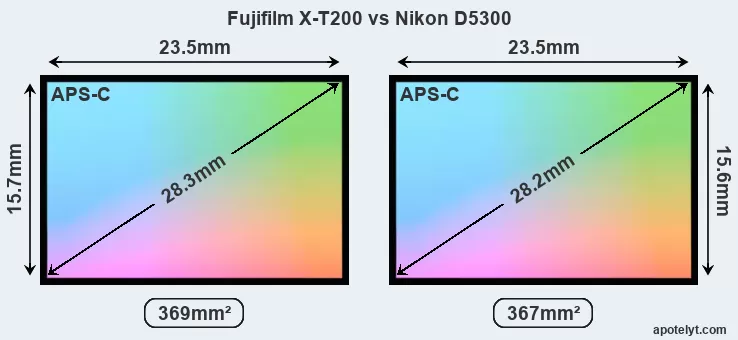
Even though the X-T200 has a slightly larger sensor, both cameras offer the same resolution of 24 megapixels. This implies that the X-T200 has a lower pixel density and larger individual pixels (with a pixel pitch of 3.92μm versus 3.91μm for the D5300), which gives it a potential advantage in terms of light gathering capacity. In addition, the X-T200 is much more recent (by 6 years and 3 months) than the D5300, and its sensor will have benefitted from technological advances during this time. Coming back to sensor resolution, it should be mentioned that the D5300 has no anti-alias filter installed, so that it can capture all the detail its sensor resolves.
The X-T200 has on-sensor phase detect pixels, which results in fast and reliable autofocus acquisition even during live view operation.
The Fujifilm X-T200 has a native sensitivity range from ISO 200 to ISO 12800, which can be extended to ISO 100-51200. The corresponding ISO settings for the Nikon D5300 are ISO 100 to ISO 12800, with the possibility to increase the ISO range to 100-25600.
Technology-wise, both cameras are equipped with CMOS (Complementary Metal–Oxide–Semiconductor) sensors. Both cameras use a Bayer filter for capturing RGB colors on a square grid of photosensors. This arrangement is found in most digital cameras.
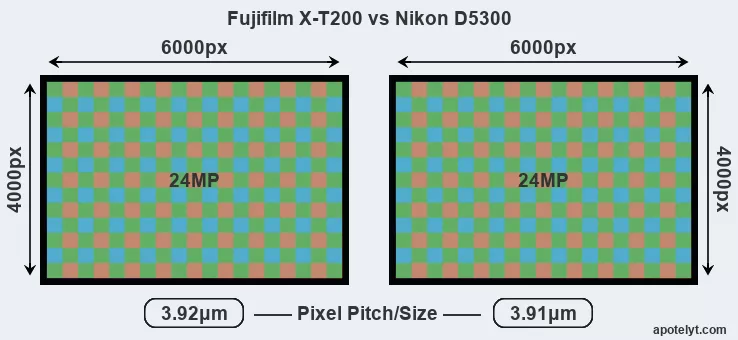
For many cameras, data on sensor performance has been reported by DXO Mark. This service assesses and scores the color depth ("DXO Portrait"), dynamic range ("DXO Landscape"), and low-light sensitivity ("DXO Sports") of camera sensors, and also publishes an overall camera score. The following table provides an overview of the physical sensor characteristics, as well as the sensor quality measurements for a selection of comparators.

| # | Camera Model |
Sensor Class |
Resolution (MP) |
Horiz. Pixels |
Vert. Pixels |
Video Format |
DXO Portrait |
DXO Landscape |
DXO Sports |
DXO Overall |
|
|---|---|---|---|---|---|---|---|---|---|---|---|
| 1. | Fujifilm X-T200 | APS-C | 24.0 | 6000 | 4000 | 4K/30p | 24.1 | 13.6 | 1991 | 84 | |
| 2. | Nikon D5300 | APS-C | 24.0 | 6000 | 4000 | 1080/60p | 24.0 | 13.9 | 1338 | 83 | |
| 3. | Fujifilm X-E4 | APS-C | 26.0 | 6240 | 4160 | 4K/30p | 24.2 | 13.7 | 2085 | 85 | |
| 4. | Fujifilm X-T30 II | APS-C | 26.0 | 6240 | 4160 | 4K/30p | 24.2 | 13.8 | 2144 | 85 | |
| 5. | Fujifilm X-T30 | APS-C | 26.0 | 6240 | 4160 | 4K/30p | 24.1 | 13.5 | 1895 | 83 | |
| 6. | Fujifilm X-A7 | APS-C | 24.0 | 6000 | 4000 | 4K/30p | 24.1 | 13.6 | 1955 | 84 | |
| 7. | Fujifilm X-T100 | APS-C | 24.0 | 6000 | 4000 | 4K/15p | 24.0 | 13.4 | 1829 | 83 | |
| 8. | Fujifilm X-E3 | APS-C | 24.0 | 6000 | 4000 | 4K/30p | 23.9 | 13.3 | 1764 | 82 | |
| 9. | Fujifilm X-T20 | APS-C | 24.0 | 6000 | 4000 | 4K/30p | 23.9 | 13.2 | 1704 | 81 | |
| 10. | Fujifilm X-A3 | APS-C | 24.0 | 6000 | 4000 | 1080/60p | 23.8 | 13.1 | 1664 | 81 | |
| 11. | Fujifilm X-E2S | APS-C | 16.0 | 4896 | 3264 | 1080/60p | 23.7 | 13.0 | 1608 | 80 | |
| 12. | Fujifilm X-T10 | APS-C | 16.0 | 4896 | 3264 | 1080/60p | 23.7 | 12.9 | 1546 | 79 | |
| 13. | Nikon D5600 | APS-C | 24.0 | 6000 | 4000 | 1080/60p | 24.1 | 14.0 | 1306 | 84 | |
| 14. | Nikon D5500 | APS-C | 24.0 | 6000 | 4000 | 1080/60p | 24.1 | 14.0 | 1438 | 84 | |
| 15. | Nikon D3300 | APS-C | 24.0 | 6000 | 4000 | 1080/60p | 24.3 | 12.8 | 1385 | 82 | |
| 16. | Nikon D3200 | APS-C | 24.1 | 6016 | 4000 | 1080/30p | 24.1 | 13.2 | 1131 | 81 | |
| 17. | Nikon D5200 | APS-C | 24.0 | 6000 | 4000 | 1080/60i | 24.2 | 13.9 | 1284 | 84 | |
| Note: DXO values in italics represent estimates based on sensor size and age. | |||||||||||
Many modern cameras cannot only take still pictures, but also record videos. The two cameras under consideration both have sensors whose read-out speed is fast enough to capture moving pictures, but the X-T200 provides a higher video resolution than the D5300. It can shoot video footage at 4K/30p, while the Nikon is limited to 1080/60p.
Feature comparison
Apart from body and sensor, cameras can and do differ across a range of features. For example, the X-T200 has an electronic viewfinder (2360k dots), while the D5300 has an optical one. Both systems have their advantages, with the electronic viewfinder making it possible to project supplementary shooting information into the framing view, whereas the optical viewfinder offers lag-free viewing and a very clear framing image. The viewfinder in the X-T200 offers a wider field of view (100%) than the one in the D5300 (95%), so that a larger proportion of the captured image is visible in the finder. In addition, the viewfinder of the X-T200 has a higher magnification (0.62x vs 0.57x), so that the size of the image transmitted appears closer to the size seen with the naked human eye. The table below summarizes some of the other core capabilities of the Fujifilm X-T200 and Nikon D5300 in connection with corresponding information for a sample of similar cameras.

| # | Camera Model |
Viewfinder (Type or 000 dots) |
Control Panel (yes/no) |
LCD Specifications (inch/000 dots) |
LCD Attach- ment |
Touch Screen (yes/no) |
Max Shutter Speed * |
Max Shutter Flaps * |
Built-in Flash (yes/no) |
Built-in Image Stab |
|
|---|---|---|---|---|---|---|---|---|---|---|---|
| 1. | Fujifilm X-T200 | 2360 | n | 3.5 / 2780 | swivel | Y | 1/4000s | 8.0/s | Y | n | |
| 2. | Nikon D5300 | optical | n | 3.2 / 1037 | swivel | n | 1/4000s | 5.0/s | Y | n | |
| 3. | Fujifilm X-E4 | 2360 | n | 3.0 / 1620 | tilting | Y | 1/4000s | 8.0/s | n | n | |
| 4. | Fujifilm X-T30 II | 2360 | n | 3.0 / 1620 | tilting | Y | 1/4000s | 8.0/s | Y | n | |
| 5. | Fujifilm X-T30 | 2360 | n | 3.0 / 1040 | tilting | Y | 1/4000s | 8.0/s | Y | n | |
| 6. | Fujifilm X-A7 | none | n | 3.5 / 2760 | swivel | Y | 1/4000s | 6.0/s | Y | n | |
| 7. | Fujifilm X-T100 | 2360 | n | 3.0 / 1040 | swivel | Y | 1/4000s | 6.0/s | Y | n | |
| 8. | Fujifilm X-E3 | 2360 | n | 3.0 / 1040 | fixed | Y | 1/4000s | 8.0/s | n | n | |
| 9. | Fujifilm X-T20 | 2360 | n | 3.0 / 1040 | tilting | Y | 1/4000s | 8.0/s | Y | n | |
| 10. | Fujifilm X-A3 | none | n | 3.0 / 1040 | tilting | Y | 1/4000s | 6.0/s | Y | n | |
| 11. | Fujifilm X-E2S | 2360 | n | 3.0 / 1040 | fixed | n | 1/4000s | 7.0/s | Y | n | |
| 12. | Fujifilm X-T10 | 2360 | n | 3.0 / 920 | tilting | n | 1/4000s | 8.0/s | Y | n | |
| 13. | Nikon D5600 | optical | n | 3.2 / 1037 | swivel | Y | 1/4000s | 5.0/s | Y | n | |
| 14. | Nikon D5500 | optical | n | 3.2 / 1037 | swivel | Y | 1/4000s | 5.0/s | Y | n | |
| 15. | Nikon D3300 | optical | n | 3.0 / 921 | fixed | n | 1/4000s | 5.0/s | Y | n | |
| 16. | Nikon D3200 | optical | n | 3.0 / 921 | fixed | n | 1/4000s | 4.0/s | Y | n | |
| 17. | Nikon D5200 | optical | n | 3.0 / 921 | swivel | n | 1/4000s | 5.0/s | Y | n | |
| Note: *) Information refers to the mechanical shutter, unless the camera only has an electronic one. | |||||||||||
One differentiating feature between the two cameras concerns the touch sensitivity of the rear screen. The X-T200 has a touchscreen, while the D5300 has a conventional panel. Touch control can be particularly helpful, for example, for setting the focus point.
Both cameras have an articulated rear screen that can be turned to be front-facing. This feature will be particularly appreciated by vloggers and photographers who are interested in taking selfies.The reported shutter speed information refers to the use of the mechanical shutter. Yet, some cameras only have an electronic shutter, while others have an electronic shutter in addition to a mechanical one. In fact, the X-T200 is one of those camera that have an additional electronic shutter, which makes completely silent shooting possible. However, this mode is less suitable for photographing moving objects (risk of rolling shutter) or shooting under artificial light sources (risk of flickering).
The Fujifilm X-T200 and the Nikon D5300 both have an intervalometer built-in. This enables the photographer to capture time lapse sequences, such as flower blooming, a sunset or moon rise, without purchasing an external camera trigger and related software.
Concerning the storage of imaging data, both the X-T200 and the D5300 write their files to SDXC cards. Both cameras can use UHS-I cards, which provide for Ultra High Speed data transfer of up to 104 MB/s.
Connectivity comparison
For some imaging applications, the extent to which a camera can communicate with its environment can be an important aspect in the camera decision process. The table below provides an overview of the connectivity of the Fujifilm X-T200 and Nikon D5300 and, in particular, the interfaces the cameras (and selected comparators) provide for accessory control and data transfer.

| # | Camera Model |
Hotshoe Port |
Internal Mic / Speaker |
Microphone Port |
Headphone Port |
HDMI Port |
USB Port |
WiFi Support |
NFC Support |
Bluetooth Support |
|
|---|---|---|---|---|---|---|---|---|---|---|---|
| 1. | Fujifilm X-T200 | Y | stereo / mono | Y | Y | micro | 3.1 | Y | - | Y | |
| 2. | Nikon D5300 | Y | stereo / mono | Y | - | mini | 2.0 | Y | - | - | |
| 3. | Fujifilm X-E4 | Y | stereo / mono | Y | - | micro | 3.2 | Y | - | Y | |
| 4. | Fujifilm X-T30 II | Y | stereo / mono | Y | - | micro | 3.2 | Y | - | Y | |
| 5. | Fujifilm X-T30 | Y | stereo / mono | Y | - | micro | 3.1 | Y | - | Y | |
| 6. | Fujifilm X-A7 | Y | stereo / mono | Y | - | micro | 2.0 | Y | - | Y | |
| 7. | Fujifilm X-T100 | Y | stereo / mono | Y | - | micro | 2.0 | Y | - | Y | |
| 8. | Fujifilm X-E3 | Y | stereo / mono | Y | - | micro | 2.0 | Y | - | Y | |
| 9. | Fujifilm X-T20 | Y | stereo / mono | Y | - | micro | 2.0 | Y | - | - | |
| 10. | Fujifilm X-A3 | Y | stereo / mono | - | - | micro | 2.0 | Y | - | - | |
| 11. | Fujifilm X-E2S | Y | stereo / mono | Y | - | micro | 2.0 | Y | - | - | |
| 12. | Fujifilm X-T10 | Y | stereo / mono | Y | - | micro | 2.0 | Y | - | - | |
| 13. | Nikon D5600 | Y | stereo / mono | Y | - | mini | 2.0 | Y | Y | Y | |
| 14. | Nikon D5500 | Y | stereo / mono | Y | - | mini | 2.0 | Y | - | - | |
| 15. | Nikon D3300 | Y | mono / mono | Y | - | mini | 2.0 | - | - | - | |
| 16. | Nikon D3200 | Y | mono / mono | Y | - | mini | 2.0 | - | - | - | |
| 17. | Nikon D5200 | Y | stereo / mono | Y | - | mini | 2.0 | - | - | - |
It is notable that the X-T200 has a headphone jack, which is not present on the D5300 This port makes it possible to attach external headphones and monitor the quality of sound during the recording process.
Travel and landscape photographers will find it useful that the D5300 has an internal geolocalization sensor and can record GPS coordinates in its EXIF data.
Both the X-T200 and the D5300 have been discontinued, but can regularly be found used on ebay. The D5300 was replaced by the Nikon D5500, while the X-T200 does not have a direct successor. Further information on the features and operation of the X-T200 and D5300 can be found, respectively, in the Fujifilm X-T200 Manual (free pdf) or the online Nikon D5300 Manual.
Review summary
So what conclusions can be drawn? Is the Fujifilm X-T200 better than the Nikon D5300 or vice versa? The listing below highlights the relative strengths of the two models.

Advantages of the Fujifilm X-T200:
- Better moiré control: Has an anti-alias filter to avoid artificial patterns to appear in images.
- Better video: Provides higher definition movie capture (4K/30p vs 1080/60p).
- Better live-view autofocus: Features on-sensor phase-detection for more confident autofocus.
- Better sound control: Has a headphone port that enables audio monitoring while recording.
- More framing info: Has an electronic viewfinder that displays shooting data.
- More complete view: Has a viewfinder with a larger field of view (100% vs 95%).
- Larger viewfinder image: Features a viewfinder with a higher magnification (0.62x vs 0.57x).
- Larger screen: Has a bigger rear LCD (3.5" vs 3.2") for image review and settings control.
- More detailed LCD: Has a higher resolution rear screen (2780k vs 1037k dots).
- Fewer buttons to press: Is equipped with a touch-sensitive rear screen to facilitate handling.
- Faster burst: Shoots at higher frequency (8 vs 5 flaps/sec) to capture the decisive moment.
- Less disturbing: Has an electronic shutter option for completely silent shooting.
- More compact: Is smaller (121x84mm vs 125x98mm) and thus needs less room in the bag.
- Less heavy: Is lighter (by 110g or 23 percent) and hence easier to carry around.
- Easier travel charging: Can be conveniently charged via its USB port.
- More legacy lens friendly: Can take a broad range of non-native lenses via adapters.
- Faster data transfer: Supports a more advanced USB protocol (3.1 vs 2.0).
- Easier wireless transfer: Supports Bluetooth for image sharing without cables.
- More affordable: Was introduced into a lower priced segment (13 percent cheaper at launch).
- More modern: Reflects 6 years and 3 months of technical progress since the D5300 launch.

Reasons to prefer the Nikon D5300:
- Maximized detail: Lacks an anti-alias filter to exploit the sensor's full resolution potential.
- Brighter framing: Features an optical viewfinder for clear, lag-free composition.
- Longer lasting: Gets more shots (600 versus 270) out of a single battery charge.
- Easier geotagging: Features an internal GPS sensor to log localization data.
- More heavily discounted: Has been around for much longer (launched in October 2013).
If the number of relative strengths (bullet points above) is taken as a guide, the X-T200 is the clear winner of the match-up (20 : 5 points). However, the relative importance of the various individual camera aspects will vary according to personal preferences and needs, so that you might like to apply corresponding weights to the particular features before making a decision on a new camera. A professional wedding photographer will view the differences between cameras in a way that diverges from the perspective of a travel photog, and a person interested in cityscapes has distinct needs from a macro shooter. Hence, the decision which camera is best and worth buying is often a very personal one.
How about other alternatives? Do the specifications of the Fujifilm X-T200 and the Nikon D5300 place the cameras among the top in their class? Find out in the latest Best Mirrorless Interchangeable Lens Camera and Best DSLR Camera listings whether the two cameras rank among the cream of the crop.
In any case, while the comparison of technical specifications can provide a useful overview of the capabilities of different cameras, it remains incomplete and does no justice, for example, to the way the X-T200 or the D5300 perform in practice. User reviews, such as those found at amazon, can sometimes inform about these issues, but such feedback is often incomplete, inconsistent, and biased.
Expert reviews
This is why hands-on reviews by experts are important. The following table reports the overall ratings of the cameras as published by some of the major camera review sites (amateurphotographer [AP], cameralabs [CL], digitalcameraworld [DCW], dpreview [DPR], ephotozine [EPZ], photographyblog [PB]). As can be seen, the professional reviewers agree in many cases on the quality of different cameras, but sometimes their assessments diverge, reinforcing the earlier point that a camera decision is often a very personal choice.

| # | Camera Model |
AP score |
CL score |
DCW score |
DPR score |
EPZ score |
PB score |
Camera Launch |
Launch Price (USD) |
Street Price |
|
|---|---|---|---|---|---|---|---|---|---|---|---|
| 1. | Fujifilm X-T200 | 3.5/5 | .. | 4/5 | 82/100 | 4/5 | 4.5/5 | Jan 2020 | 699 | ebay.com | |
| 2. | Nikon D5300 | 4/5 | + + | .. | 79/100 | 4.5/5 | 4.5/5 | Oct 2013 | 799 | ebay.com | |
| 3. | Fujifilm X-E4 | 4/5 | .. | 4/5 | .. | 4.5/5 | 4/5 | Jan 2021 | 849 | amazon.com | |
| 4. | Fujifilm X-T30 II | 5/5 | .. | 4/5 | .. | 4.5/5 | 4.5/5 | Sep 2021 | 899 | amazon.com | |
| 5. | Fujifilm X-T30 | 5/5 | + + | 5/5 | 84/100 | 4.5/5 | 4.5/5 | Feb 2019 | 899 | ebay.com | |
| 6. | Fujifilm X-A7 | 3/5 | .. | 3.5/5 | 81/100 | 4/5 | 3.5/5 | Sep 2019 | 499 | ebay.com | |
| 7. | Fujifilm X-T100 | 4/5 | + | 4.5/5 | 79/100 | 4/5 | 4.5/5 | May 2018 | 599 | ebay.com | |
| 8. | Fujifilm X-E3 | 4.5/5 | + | 4.5/5 | 84/100 | 4.5/5 | 4.5/5 | Sep 2017 | 899 | ebay.com | |
| 9. | Fujifilm X-T20 | 5/5 | + + | 5/5 | 82/100 | 5/5 | 4.5/5 | Jan 2017 | 899 | ebay.com | |
| 10. | Fujifilm X-A3 | .. | .. | .. | 74/100 | 4.5/5 | 4/5 | Aug 2016 | 399 | ebay.com | |
| 11. | Fujifilm X-E2S | 4.5/5 | .. | .. | 77/100 | 4.5/5 | 4.5/5 | Jan 2016 | 699 | ebay.com | |
| 12. | Fujifilm X-T10 | 4.5/5 | + + | .. | 80/100 | 5/5 | 5/5 | May 2015 | 799 | ebay.com | |
| 13. | Nikon D5600 | 4/5 | .. | 4/5 | 79/100 | 4.5/5 | 4/5 | Nov 2016 | 699 | ebay.com | |
| 14. | Nikon D5500 | 5/5 | + | .. | 79/100 | 4.5/5 | 4.5/5 | Jan 2015 | 899 | ebay.com | |
| 15. | Nikon D3300 | 3/5 | + | .. | 77/100 | 4.5/5 | 4.5/5 | Jan 2014 | 499 | ebay.com | |
| 16. | Nikon D3200 | 5/5 | + + | .. | 73/100 | 4.5/5 | 4.5/5 | Apr 2012 | 599 | ebay.com | |
| 17. | Nikon D5200 | 4/5 | + + | .. | 79/100 | 4.5/5 | 4.5/5 | Nov 2012 | 749 | ebay.com | |
| Note: (+ +) highly recommended; (+) recommended; (o) reviewed; (..) not available. | |||||||||||
The above review scores should be interpreted with care, though. The ratings are only valid when referring to cameras in the same category and of the same age. A score, therefore, has to be seen in close connection to the price and market introduction time of the camera, and comparisons of ratings among very different cameras or across long time periods have little meaning. It should also be noted that some of the review sites have over time altered the way they render their verdicts.

Check X-T200 offers at
ebay.com

Check D5300 offers at
ebay.com
Other camera comparisons
Did this review help to inform your camera decision process? If you would like to see a different side-by-side camera review, just use the search menu below. There is also a set of direct links to comparison reviews that other users of the CAM-parator app explored.
- Canon 1D C vs Nikon D5300
- Canon T5i vs Fujifilm X-T200
- Fujifilm X-T200 vs Leica M-E Typ 240
- Fujifilm X-T200 vs Olympus E-M1 II
- Fujifilm X-T200 vs Panasonic FZ2500
- Fujifilm X-T200 vs Panasonic G9
- Fujifilm X-T200 vs Pentax K-3 II
- Nikon D5300 vs Nikon D5500
- Nikon D5300 vs Olympus E-PL1
- Nikon D5300 vs Panasonic GX850
- Nikon D5300 vs Panasonic LF1
- Nikon D5300 vs Panasonic S5
Specifications: Fujifilm X-T200 vs Nikon D5300
Below is a side-by-side comparison of the specs of the two cameras to facilitate a quick review of their differences and common features.
| Camera Model | Fujifilm X-T200 | Nikon D5300 |
|---|---|---|
| Camera Type | Mirrorless system camera | Digital single lens reflex |
| Camera Lens | Fujifilm X mount lenses | Nikon F mount lenses |
| Launch Date | January 2020 | October 2013 |
| Launch Price | USD 699 | USD 799 |
| Sensor Specs | Fujifilm X-T200 | Nikon D5300 |
| Sensor Technology | CMOS | CMOS |
| Sensor Format | APS-C Sensor | APS-C Sensor |
| Sensor Size | 23.5 x 15.7 mm | 23.5 x 15.6 mm |
| Sensor Area | 368.95 mm2 | 366.6 mm2 |
| Sensor Diagonal | 28.3 mm | 28.2 mm |
| Crop Factor | 1.5x | 1.5x |
| Sensor Resolution | 24 Megapixels | 24 Megapixels |
| Image Resolution | 6000 x 4000 pixels | 6000 x 4000 pixels |
| Pixel Pitch | 3.92 μm | 3.91 μm |
| Pixel Density | 6.50 MP/cm2 | 6.55 MP/cm2 |
| Moiré control | Anti-Alias filter | no AA filter |
| Movie Capability | 4K/30p Video | 1080/60p Video |
| ISO Setting | 200 - 12,800 ISO | 100 - 12,800 ISO |
| ISO Boost | 100 - 51,200 ISO | 100 - 25,600 ISO |
| DXO Sensor Quality (score) | .. | 83 |
| DXO Color Depth (bits) | .. | 24.0 |
| DXO Dynamic Range (EV) | .. | 13.9 |
| DXO Low Light (ISO) | .. | 1338 |
| Screen Specs | Fujifilm X-T200 | Nikon D5300 |
| Viewfinder Type | Electronic viewfinder | Optical viewfinder |
| Viewfinder Field of View | 100% | 95% |
| Viewfinder Magnification | 0.62x | 0.57x |
| Viewfinder Resolution | 2360k dots | |
| LCD Framing | Live View | Live View |
| Rear LCD Size | 3.5inch | 3.2inch |
| LCD Resolution | 2780k dots | 1037k dots |
| LCD Attachment | Swivel screen | Swivel screen |
| Touch Input | Touchscreen | no Touchscreen |
| Shooting Specs | Fujifilm X-T200 | Nikon D5300 |
| Focus System | On-Sensor Phase-detect | Phase-detect AF |
| Manual Focusing Aid | Focus Peaking | no Peaking Feature |
| Continuous Shooting | 8 shutter flaps/s | 5 shutter flaps/s |
| Electronic Shutter | up to 1/32000s | no E-Shutter |
| Time-Lapse Photography | Intervalometer built-in | Intervalometer built-in |
| Fill Flash | Built-in Flash | Built-in Flash |
| Storage Medium | SDXC cards | SDXC cards |
| Single or Dual Card Slots | Single card slot | Single card slot |
| UHS card support | UHS-I | UHS-I |
| Connectivity Specs | Fujifilm X-T200 | Nikon D5300 |
| External Flash | Hotshoe | Hotshoe |
| USB Connector | USB 3.1 | USB 2.0 |
| HDMI Port | micro HDMI | mini HDMI |
| Microphone Port | External MIC port | External MIC port |
| Headphone Socket | Headphone port | no Headphone port |
| Wifi Support | Wifi built-in | Wifi built-in |
| Bluetooth Support | Bluetooth built-in | no Bluetooth |
| Geotagging | no internal GPS | GPS built-in |
| Body Specs | Fujifilm X-T200 | Nikon D5300 |
| Battery Type | Fujifilm NP-W126S | Nikon EN-EL14a |
| Battery Life (CIPA) | 270 shots per charge | 600 shots per charge |
| In-Camera Charging | USB charging | no USB charging |
| Body Dimensions |
121 x 84 x 55 mm (4.8 x 3.3 x 2.2 in) |
125 x 98 x 76 mm (4.9 x 3.9 x 3.0 in) |
| Camera Weight | 370 g (13.1 oz) | 480 g (16.9 oz) |

Check X-T200 offers at
ebay.com

Check D5300 offers at
ebay.com
Did you notice an error on this page? If so, please get in touch, so that we can correct the information.
